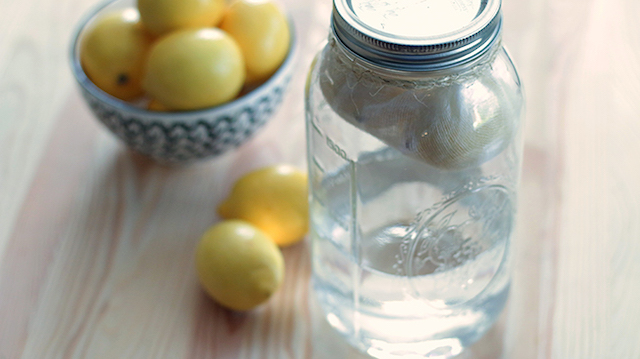There are few things more Italian than limoncello, the sweet yellow liqueur made from lemons, sugar, alcohol and water. The perfect aperitif and digestif, limoncello’s citrusy punch is refreshing and unique.
Its origins, however, are mysterious. No one knows exactly when and where limoncello was first created. Capri, Amalfi and Sorrento all claim to be home to the signature Italian treat, supposedly created around the turn of the 20th century, but its true history is as murky as the viscous spirit itself.
Luckily for us, though, the recipes for limoncello weren’t lost with the tales of its beginnings. And while there are many ways to make it, these are two of the most effective and popular methods for brewing the sweet and syrupy liqueur.
The Long Brew Method
 This method provides the most authentic lemon flavor, with no bitterness or impurities, but it takes up to three months to make.
This method provides the most authentic lemon flavor, with no bitterness or impurities, but it takes up to three months to make.
Perhaps the purest way to make limoncello involves suspending three lemons above a 100 proof base spirit in an airtight glass container for two to three months. This process, common in Sicily, assures that the alcohol never touches the lemons directly. Instead, the spirit evaporates, condenses and precipitates in the closed system, drawing all of the essential oils from the lemon skins with none of the bitterness of the pith.
Using cheesecloth and a long piece of twine, make a bundle of three lemons. Tie it up very tightly so the lemons are secure. You’ll want to have a lot of excess twine on your bundle in order to suspend the lemons later.
 Choose fresh lemons with thick, porous skins. Be sure to wash and dry them before you bundle them. It’s also advisable to choose organic lemons, as whatever the lemon’s skin has been exposed to will make its way into your limoncello.
Choose fresh lemons with thick, porous skins. Be sure to wash and dry them before you bundle them. It’s also advisable to choose organic lemons, as whatever the lemon’s skin has been exposed to will make its way into your limoncello.
Pour a 750mL bottle of high-proof spirit, like Everclear, in a large glass container. A large mason jar works perfectly because there is plenty of room for the lemons to hang, and the lip of the jar helps secure them. Cut off any excess cheesecloth from the top of the bundle and suspend the lemons inside the glass container using the excess twine to wrap around the neck of the jar. Make sure the lemons aren’t touching the liquid. Screw the lid over the twine until completely sealed. Store in a cool, dark place for two to three months.
Once the wait is over, your alcohol will be a translucent pale yellow. Remove the lemon bundle from the jar. In a separate container, combine 1.5 cups turbinado sugar with 1.5 cups of room-temperature still mineral water (distilled water works fine as well). Stir until all of the sugar is dissolved.
 In this method, the lemon flavor is achieved by suspending the lemons inside the glass container.
In this method, the lemon flavor is achieved by suspending the lemons inside the glass container.
Pour the sugar syrup slowly into the alcohol, stirring frequently so the cordial is well blended. Taste as you go to achieve the level of sweetness you desire. You can serve your limoncello right away, or for a smoother spirit, store it for another month, strain and then serve room-temperature or chilled. Once fully brewed, limoncello is best stored in the freezer.
The Short Brew Method
 The short brew method for making limoncello is delightfully easy and relatively quick.
The short brew method for making limoncello is delightfully easy and relatively quick.
If you’re on a deadline, this is a quick and easy method for making limoncello that still tastes amazing. This recipe is also the most standard method, and it only takes seven days. For this recipe, you’ll need 12 organic lemons and a microplane for zesting.
In a large mason jar, gently zest each lemon, being careful not to zest any of the white pith underneath the thin yellow skin. This is the most time-consuming part of the process, but it is well worth the effort. Once all of your lemons have been zested into the jar, pour your 750mL bottle of Everclear (or any clear high-proof spirit) over the lemon zest.
 Zesting 12 lemons takes time, but it expedites the infusion process drastically.
Zesting 12 lemons takes time, but it expedites the infusion process drastically.
Screw the lid on tight and allow to sit in a cool, dark place for seven days (or longer for a more intense flavor). Over time, you will see the bright yellow coloring lift off of the zest and into the spirit.
After seven days, strain the zest out of your spirit using a fine mesh strainer or cheesecloth. I recommend straining it several times to ensure that there is no sediment left behind.
 Strain the liquid repeatedly, until your limoncello is free from any zest and left only with its powerful flavor.
Strain the liquid repeatedly, until your limoncello is free from any zest and left only with its powerful flavor.
From here, you’ll follow the same instructions as above with the Sicilian method. Stir 1.5 cups of organic turbinado sugar into 1.5 cups of room-temperature mineral water. Again, you can also use the same ratio with bleached sugar if you’re seeking that vibrant pure yellow hue of traditional limoncello. Once all of the sugar is dissolved, slowly stir it into your spirit until you’ve reached your desired level of sweetness.
You can serve it immediately, but for a richer, more developed flavor, you can store the limoncello in a cool, dark place for another month before serving. The result is a viscous, bright amber cordial perfect for sipping before and after meals.
 Whether to be enjoyed by itself or in a cocktail, limoncello is a cordial worth keeping on hand.
Whether to be enjoyed by itself or in a cocktail, limoncello is a cordial worth keeping on hand.
Limoncello is delicious with prosecco, champagne and tonic, or in cocktails. You can also experiment with different flavors, like lime-cello, grapefruit-cello, or even infused limoncello (tea-infused blueberry limoncello, anyone?). With some creativity and a passion for spirits, there’s a whole world of possibilities to try.





